The boat with three rudders
Comparative tests of three rudder systems
In 1999 there were informal discussions about the possibility of developing a new expedition sea kayak in Adelaide. That did not proceed, but to assist with planning I investigated three alternative rudder systems, all rather different from the standard 270° retracting rudder devised in 1981 by one of the pioneers of sea kayaking in Australia, Tasmanian Laurie Ford, and now used world-wide.
Two of these systems were based on those I had investigated in the mid-1980s before deciding that retractable fin systems offered better performance with less complexity. The third was based on another system used by Laurie Ford and, more recently, by Dagger. A similar, but smaller, rudder was available in UK-built Nordkapps, but was later abandoned by the manufacturer.
V-Trim
I had earlier had two concerns about stern-mounted rudders: they were often clear of the water in rough seas, and they were vulnerable and hazardous on the extreme stern. V-Trim was an attempt to overcome those concerns, by moving the rudder forward of the stern and retracting the blade flat on the deck. (The name V-Trim came from V for Viking: the Vikings had their steering oars outboard of the hull, as was common at the time. The rudder was on the port rather than the steerboard side to use an existing cable run.)
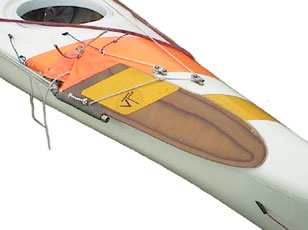
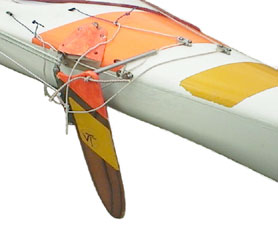
This produced a mechanism described by Mike Emery, editor of the Tasmanian club’s Sea Canoeing, as ‘a fascinating piece of engineering’ when it was written up in the March 1985 issue, and by a colleague as a ‘Chinese puzzle.’ I used it for a time on my Nordkapp, but later replaced it with a Voyager retractable fin.
As a rudder it worked well enough, but its drag was noticeable. I presumed then, and still do, that it was interference drag, caused by the blade disrupting the flow along the hull. Stern-mounted rudders work in the wake of the hull, where they generate some drag, but not by affecting the hull flow.
The drag was also obvious when the system was installed on the Voyager for these experiments.
Under hull
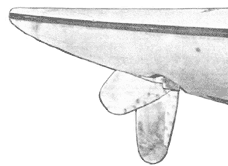
The idea of a rudder retracting into the hull is an attractive one: the blade is forward of the stern and the deck is left clear. A German kayak, the Habel, had such a rudder, but many details of its design were not clear from the brochure (in German). The blade appears to be metal, pivoting in a stock within the line of the keel.
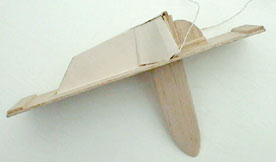
I devised a way of retracting a blade into an under-hull case and varying its angle for steering, with the blade as the only moving part. The model worked, but it was clear that there would be a fairly large slot for its retraction, and that meant drag.
In the event, some ideas from the model found their way into the Voyager retractable fin system. For these experiments I worked in reverse: the blade and case were made with the fin moulds, with additions for the extra length or width.
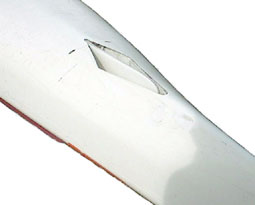
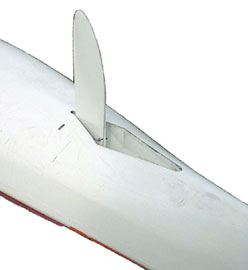
Under stern
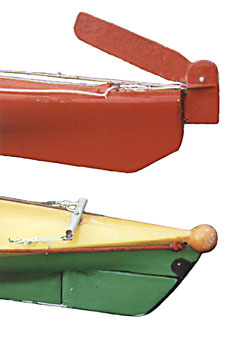
Simply pivoting the aft end of the hull as a rudder has an obvious attraction, and the idea has been used by a number of others. Laurie Ford used such a rudder on his Longboat, a stretched North Sea Tourer. His rudder has a substantial stainless steel guard rail around it. (Laurie’s view was that this was a ‘one off’ for the Longboat, and that the 270° retracting system was the universal one, for any boat. Upper boat in the pic is a Greenlander II.)
Some Dagger sea kayaks used similar rudders, with low aspect ratio ‘blades’. These rudders have their mechanism enclosed beneath an access panel in the deck and can be locked straight. (I am not sure whether the patent covers the blade or the locking mechanism.) Dagger claimed minimal drag for the rudder, although I had doubts about the effectiveness.
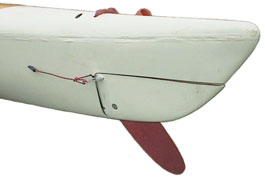
In my case, I cut out the stern section of the hull, and closed the gap with a bulkhead. The rudder pivots around a vertical bolt, which can be removed downwards. The vertical part of the bulkhead carries the lower pivot, the horizontal section the nut for the pivot bolt.
The leading edge was faired and a length of pierced stainless steel strip used for the steering arms. A retracting blade was cut from aluminium sheet. It works through a slot cut in the lower edge, lowered by shock cord and raised by a cord controlled from the cockpit.
In the cockpit
This particular boat had no footrest system: appropriately sized blocks of polystyrene were used as footrests. The ends of the rudder bar (telescoping to cope with the tapering width of the cockpit) are slides (RF 370) running in standard yacht tracks (RF 363). Length adjustment is with a tubular cleat on each side, and the steering cables are shackled to the cleats. To avoid footrest loads being applied to the rudder mechanisms a cord (Spectra) ran through sheaves at the aft cockpit bulkhead connecting both ends of the rudder bar. Only one rudder was connected at a time.
The system worked well enough for these experiments, but suffered considerable ‘stiction’, and like all such systems felt very vague as far as bracing was concerned. The bar had to be ‘pumped’ to make steering movements, and response was therefore slow.
The boat
The boat used for these experiments was the original 1985 Voyager prototype, a boat which has been used for a number of other experiments (and was later used to develop new sail rigs): having an old boat lying around can be useful at times. It has an overall length of 459cm, a beam of 60cm, and is of pronounced Swedish form. This boat had a cockpit with bulkheads, including side bulkheads, rather than the integrated cockpit of later examples.
The V-Trim rudder was installed on the deck, while the existing fin case was removed to fit the new case for the rudder. As noted above, the stern area of the hull was cut out and used to make the stern rudder.

In operation
The first outing was in the northern part of West Lakes, in the early morning to avoid wind and wave, and the boat was paddled over a course measured at .582nm (1078m) as measured with a SpeedMate log.
The first run was with the under-hull slot taped over, the time being 8:33. The second run, with the tape removed, took 8:59: as expected, the drag was considerable, obviously unacceptably so.
The third run, with the slot still open, was with VTrim deployed—9:41—again showing unacceptable drag.
Some manoeuvring was then carried out with each rudder in turn. Both forward-mounted rudders were effective, but not remarkably so. The stern rudder was equally effective on flat water, and with the blade extended was more than adequate.
Subsequent runs were off the metropolitan coast, and revealed no surprises. Both the forward-mounted rudders had sufficient power to control the boat in the relatively light conditions used. The stern rudder also had sufficient power, in fact I found myself overcorrecting, partly due to the slowness of the rudder bar and cables, while sailing.
Conclusions
Both V-Trim and the under hull rudder cause unacceptable drag, one through interference, the other through the large opening needed to accomodate the blade’s steering movements. Given the somewhat fiddly nature of V-Trim it is hardly worth developing further anyway.
At the cost of additional complexity the under-hull rudder might be developed, but it seems questionable. Farther aft it would be more effective than in the position used for a retractable fin.
The stern rudder showed some promise. Mechanically and structurally it is the simplest of the three. This version was somewhat fragile, having only a 4.8mm diameter bolt for its pivot. Given that boats are often dragged on their sterns or collide with objects, a considerably heavier pivot and other parts, preferably readily replaceable, would be needed. Sand inside, restricting the movement of the retractable blade was also a problem. A thicker blade and greater clearances would be needed in a developed version. There is ample room under the deck in Voyager for any mechanism to be enclosed. Some form of lock to hold it straight, as in the Dagger system, would be useful.
The Australian Mirage kayaks use such rudders, without the retracting blade, or the guard that Laurie Ford used. There are two types of blade, one extending some 8cm below the keel line, the other flush.
For a boat the size of Voyager I still think a rudder is unnecessary. A retractable fin provides adequate control, and with only one moving part is simpler to make and maintain. The small slot causes minimal drag. However for longer expedition boats with little rocker the fin is less effective and rudders would appear to be the better choice. The stern rudder, with or without a retractable blade, appears worth considering for such craft. The real question relates to its effectiveness. More testing is called for.
There is no one right answer...
Postscript December 2000
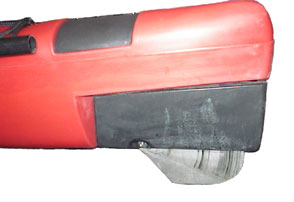
I have now discovered that the Australis Trilogy, an Australian-built sea kayak, uses a rudder similar to my stern rudder, complete with retracting plate for added area. In this case the plate is more substantial, does not retract completely, and is gravity operated. There is no retraction control, so it lifts only on contact.
It is not as neat overall as the Dagger system, and given the size and rocker of the boat, I think a retractable fin would have been a better choice.
Postscript July 2003
It’s telling that later boats from Dagger reverted to 270° retracting rudders. Clearly their integral rudder system was not as effective as they’d hoped. Also telling is the fact that I was asked to fit a Voyager fin into a locally owned Dagger Sitka, making it the only boat I knew with both rudder and fin. (Dagger no longer makes sea kayaks, or their range of open canoes.)
Postscript Mayy 2019
Two UK manufacturers now produce combined fin/rudder systems. One, by Kari-Tek, uses hydraulics for both retraction and steering. One would question serviceability in the field.
The other, by Pyranha brands P&H and Venture kayaks, is known as the ‘Skudder’. There’s a good review at Sea kayaking with seakayakphoto.com.
The idea obviously has merit, but needs more development than I put into it.
References
Carter, P, ‘Rudders: a sideways view’ in Emery, M (Ed) Sea Canoeing, No 3 March 1985, Tasmanian Sea Canoeing Club
Pietsch, J, Habel brochure